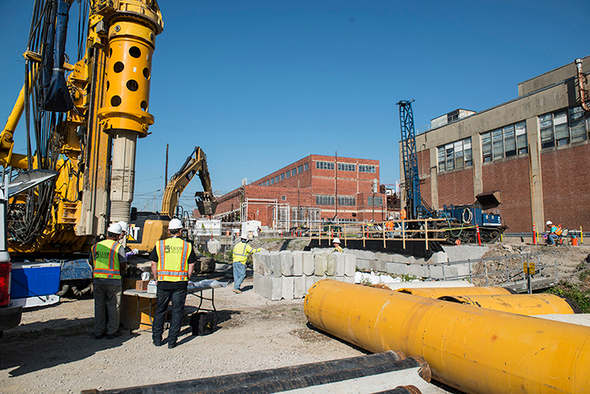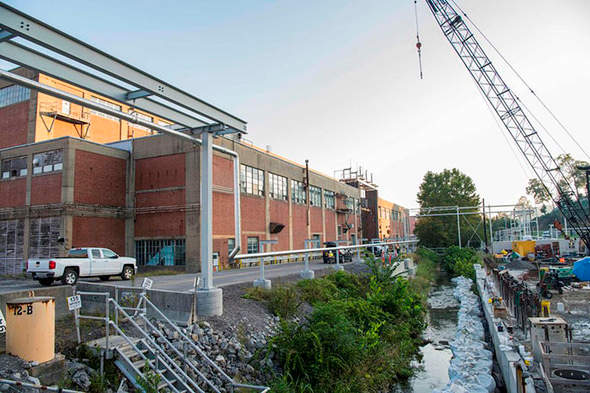
Site preparation crews constructed two secant pile retaining walls to retain soils, control water seepage, and provide a deep, secure foundation for the water intake structure at the new Mercury Treatment Facility at Y-12 National Security Complex. (Photo via DOE’s EM Update on Tuesday, Dec. 11, 2018)
The U.S. Department of Energy announced Tuesday that it has completed the site preparations for the construction of the Mercury Treatment Facility at the Y-12 National Security Complex.
The Mercury Treatment Facility will allow DOE to clean up and demolish several large Y-12 buildings that used mercury to separate lithium for use in nuclear weapons during the Cold War (in the 1950s and 1960s). It’s part of a large-scale cleanup and demolition project at Y-12 and an effort to reduce the amount of mercury in East Fork Poplar Creek, which flows through Oak Ridge.
DOE announced on Tuesday, December 4, that it had awarded a $91 million contract to build the Mercury Treatment Facility at Y-12. The contract, which could be in place for up to four years, was awarded to APTIM-North Wind Construction JV LLC.
DOE said early site preparation activities were started by other contractors in December 2017. A groundbreaking was held at the site in November 2017, and UCOR, DOE’s lead cleanup contractor in Oak Ridge, began work at the treatment facility site with a subcontractor after the groundbreaking, the DOE Oak Ridge Office of Environmental Management said in a story published Tuesday in an EM Update.
The Mercury Treatment Facility will have two components: a headworks facility and a treatment plant connected by a pipeline. The headworks facility will capture creek flow on the west end of Y-12, store excess stormwater collected during large rainfalls, remove grit, and pump water through the pipeline to the treatment plant on the east side of Y-12. The treated water will then flow into East Fork Poplar Creek.
At the future headworks site, the site preparation crews re-routed a steam condensate return line, demolished abandoned concrete structures, and installed two retaining walls, DOE said. The south secant pile retaining wall consists of 65 piles installed at depths of 20 to 40 feet. The north wall consists of 19 piles drilled approximately 16 feet deep.
“These walls will retain soils, control water seepage, and provide a deep, secure foundation for the water intake structure to divert Upper East Fork Poplar Creek waters into the headworks portion of the facility,” DOE said.
The department said the site preparation has reduced risks for the construction project as crews routed mechanical and electrical utilities to the site boundaries, removed small structures in the area, and cleared vegetation along creek banks.
Construction of the Mercury Treatment Facility is expected to begin in early 2019. Once it is operating, the treatment facility will have a treatment capacity of 3,000 gallons per minute and a storage capacity of two million gallons.
Mercury cleanup is the highest environmental management (cleanup) priority at Y-12. Operations used large amounts of mercury during the 1950s and 1960s, and a portion was lost into the environment, DOE said.
“When complete, the new facility opens the door for demolition of Y-12’s large, deteriorated, former mercury-use facilities and soil remediation beneath those buildings,” DOE said.

Employees dug up to 40 feet in the ground in some cases to pour concrete for the retaining wall for the new Mercury Treatment Facility at Y-12 National Security Complex. (Photo via DOE’s EM Update on Tuesday, Dec. 11, 2018)
Officials sometimes refer to the area where the headworks facility will be built as Outfall 200. That’s the area where the storm drain system at Y-12 discharges at the headwaters of Upper East Fork Poplar Creek. It’s in an area near the Beta 1 and Beta 3 buildings on the south side of Y-12’s main production area.
Y-12 was initially built in 1943 to enrich uranium as part of World War II’s Manhattan Project, but the site soon became an integral part of Cold War weapons production. The process that was used until 1963 to separate lithium for those operations required the use of thousands of pounds of mercury.
When complete, the new Mercury Treatment Facility will allow the demolition of Alpha 4, Alpha 5, and Beta 4, large, deteriorated buildings that once used mercury and date back to the 1940s. After their removal, the DOE Oak Ridge Office of Environmental Management will remediate the soils beneath them. The Mercury Treatment Facility will limit and control potential mercury releases as crews take down those buildings and address the soils, work that could disrupt the mercury-contaminated area on the west end of Y-12.
The Mercury Treatment Facility could reduce the flow of mercury, which travels from west to east at Y-12, by an estimated 84 percent. The treatment plant will be modular, and officials will be able to scale it to allow for expansion and to provide flexibility.
DOE cleanup work in Oak Ridge is expected to move to Y-12 and Oak Ridge National Laboratory after it’s completed at the East Tennessee Technology Park (the former K-25 site) around 2020.
East Fork Poplar Creek starts at a spring at Y-12 and flows through central Oak Ridge before joining West Fork Poplar Creek at East Tennessee Technology Park.
Most information in this story was published in an EM Update published Tuesday, December 11, by the DOE Office of Environmental Management. Mike Butler of UCOR contributed to that story.
Lean more about the Mercury Treatment Facility construction contract award here.
Learn more and see our story on last year’s groundbreaking ceremony here.
More information will be added as it becomes available.

A view of the Outfall 200 area, where the headwaters originate for the Upper East Fork Poplar Creek. The U.S. Department of Energy is building a Mercury Treatment Facility that will allow the demolition of several large mercury-contaminated buildings at the Y-12 National Security and reduce the flow of mercury into East Fork Poplar Creek. (Photo via DOE’s EM Update on Tuesday, Dec. 11, 2018)
Most news stories on Oak Ridge Today are free, brought to you by Oak Ridge Today with help from our advertisers, contributors, and subscribers. This is a free story. Thank you to our advertisers, contributors, and subscribers. You can see what we cover here.
Do you appreciate this story or our work in general? If so, please consider a monthly subscription to Oak Ridge Today. See our Subscribe page here. Thank you for reading Oak Ridge Today.
Copyright 2018 Oak Ridge Today. All rights reserved. This material may not be published, broadcast, rewritten, or redistributed.
Leave a Reply